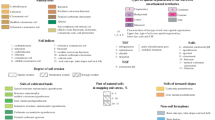Summary
A map of soil series showing peculiarities of structure, composition and state of rocks occurring to a depth of 10 m is intended for planners and engineers who do not have a special geological education. Structure, composition and state of the soil series, including temperature of the permafrozen soil series and a degree of moistening of thawed and unfrozen series is presented in colour and shades of colour a degree of ice content in permafrozen series, depth of occurrence of groundwaters and their aggressiveness are shown by a dashed line. Assessment of a territory should be started with “A map of soil series” and then passed over to an investigation of other engineering geological factors presented on the engineering geological map. Such a sequence of work will enable more rational use of extensive data on engineering geological conditions of territories obtained during their mapping.
Résumé
Une carte des séries de sols indiquant les particularités de structure et de composition et l'état des roches jusqu'à une profondeur de 10 m est présentée aux planificateurs et aux ingénieurs qui n'ont pas reçu une formation géologique spéciale. La structure, la composition et l'état des séries de sols, y compris la température des pergélisols et le degré d'humidité des séries déglées et non gelées, sont représenteés par des couleurs et des nuances; la quantité de glace présente dans les pergélisols, la profondeur du niveau hydrostatique et l'agressivité des eaux sont représentées par des lignes brisées. L'inventaire d'un territoire devrait commencer par “une carte des séries de sols” et se poursuivre par une recherche d'autres facteurs géotechniques qu'on représente sur une carte géotechnique. Une telle suite de travaux permettra un emploi plus rationnel de la documentation abondante réunie au cours du levé de carte.
Similar content being viewed by others
References
SERGEEV E.M.—GERASIMOVA A.S.—TROFIMOV V.T. (1972): Report of Explanations to the Engineering Geological Map of Western Siberian Plate, MGU Publishing House, Moscow.
FADEEV P.I. (1963): Soil series of the Metshora lowland and its structure, “Problems of Engineering Geology and Soil Study”, MGU Publishing House, Moscow.
Author information
Authors and Affiliations
Rights and permissions
About this article
Cite this article
Gerasimova, A.S., Sergeev, E.M. & Trofimov, V.T. Principles of compiling a map of soil series. Bulletin of the International Association of Engineering Geology 19, 96–97 (1979). https://doi.org/10.1007/BF02600457
Published:
Issue Date:
DOI: https://doi.org/10.1007/BF02600457




